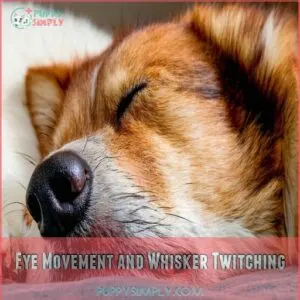This site is supported by our readers. We may earn a commission, at no cost to you, if you purchase through links.
 When your dog’s whimpering in sleep sounds like a canine soap opera, don’t panic. It’s usually just a peek into their dreamland adventure.
When your dog’s whimpering in sleep sounds like a canine soap opera, don’t panic. It’s usually just a peek into their dreamland adventure.
During REM sleep, dogs process daily experiences through vivid dreams, which can trigger twitches, leg movements, and yes, those heart-tugging whimpers.
While occasional whimpering is normal, persistent or intense sounds might signal stress, anxiety, or underlying health issues.
Most of the time, it’s simply your pup reliving chasing squirrels or playing fetch. Just like humans, dogs experience complex dream cycles that help them mentally and emotionally recharge.
Want to know when those cute whimpers might mean something more? It’s usually just a peek into their dreamland adventure. Most of the time, it’s simply your pup reliving chasing squirrels or playing fetch. Persistent or intense sounds might signal stress, anxiety, or underlying health issues.
Table Of Contents
- Key Takeaways
- Why Dogs Whimper in Their Sleep
- Dog Sleep Patterns and Cycles
- Recognizing Signs of Dreaming in Dogs
- Distinguishing Between Dreaming and Medical Issues
- Why Dogs Whimper During REM Sleep
- How to Handle a Whimpering Dog
- Understanding Canine Sleep Behavior
- When to Seek Veterinary Care
- Frequently Asked Questions (FAQs)
- Why do dogs whimper in their sleep?
- Why is my dog whimpering?
- Is it normal for a puppy to whimper while sleeping?
- Why is my dog whimpering during REM sleep?
- Why is my dog dreaming and whimpering?
- Why does my dog whimper at the door?
- Why does my dog whimper in his sleep?
- Should I wake my dog up if he’s whimpering?
- Why does my dog make a whimpering sound?
- Why does my dog make weird noises while sleeping?
- Conclusion
Key Takeaways
- Your dog’s sleep whimpering is typically a normal part of its dreaming process, where it’s processing daily experiences and emotions during REM sleep cycles.
- You’ll want to observe, but not interrupt, your dog’s sleep – most whimpers are harmless and represent your pup reliving memories or playing out dream adventures.
- Pay attention to persistent or intense whimpering that’s accompanied by other symptoms, as it could signal underlying health issues like pain, anxiety, or neurological concerns.
- Dogs experience complex sleep patterns similar to humans, with their dreams revealing fascinating insights into their emotional and mental processing during rest.
Why Dogs Whimper in Their Sleep
Have you ever wondered why your furry friend lets out soft whimpers during their nightly slumber?
Just like humans, dogs experience vivid dreams during REM sleep.
where they might relive daily experiences, process emotions, or simply twitch and murmur in response to their dream world.
Normal Sleep Behavior
The gentle rise and fall of a sleeping dog’s chest tells a story of peaceful slumber. Dog sleep is a fascinating world of rest and recovery, where both puppies and senior dogs experience unique sleep patterns.
As senior dogs enter their golden years, they often require special senior dog sleep needs to be met.
- Sleep is vital for your dog’s physical and mental health
- Different breeds have varying sleep positions and durations
- Puppies and older dogs tend to sleep more than adult dogs
From twitching paws to soft whimpers, your furry friend’s sleep is a complex dance of biological and restoration.
Stress and Anxiety
Anxiety can turn a dog’s dreamland into a restless playground, triggering whimpers that echo deeper emotional struggles.
Stress signs during sleep might include frequent twitching, low-pitched whines, or sudden movements that suggest your furry friend’s inner turmoil.
Notably, dogs can detect human emotions, including anxiety and stress, through emotional support cues.
Understanding these anxiety triggers helps you provide comfort and support, creating a safer sleep environment for your stressed pup.
Pain and Medical Issues
When stress gives way to deeper concerns, your dog’s whimpering might signal more than just bad dreams.
Persistent sleep disruptions could indicate underlying health challenges.
Joint pain, neurological disorders, or acute physical trauma often manifest through nighttime vocalizations.
It’s essential to recognize dog yelping in pain signs to identify the root cause of their whimpering.
Vet visit needed? Watch for sudden changes, ongoing discomfort, or emergency symptoms that demand professional attention and compassionate care.
Dog Sleep Patterns and Cycles
You mightn’t realize it, but your furry friend’s sleep is a lot more complex than you’d think.
Dogs cycle through different sleep stages, including REM and slow-wave sleep, which are surprisingly similar to human sleep patterns.
and can reveal fascinating insights into their emotional and physical experiences.
REM Sleep and Dreaming
Ever caught your furry friend twitching and whimpering during a deep snooze?
Dogs experience REM sleep stages just like humans, diving into a world of vivid dog dreams.
During these cycles, your pup’s brain buzzes with activity, processing daily experiences and emotions. Rapid eye movements, leg twitches, and soft whimpers reveal the rich inner life unfolding behind those closed eyelids. REM sleep stages and vivid dog dreams.
Slow-Wave Sleep and Rest
Drifting into slow-wave sleep, your dog experiences a deep, restorative phase essential for overall health.
Unlike REM sleep‘s active dreaming, this stage allows complete physical and mental recovery. Your pup’s breathing becomes regular, muscles relax, and the body repairs itself.
During these restful moments, dogs recharge, storing energy for playful adventures ahead.
For better sleep, consider a dog sleep aid, such as calming treats or supplements, to promote relaxation and a peaceful slumber, like those found in dog sleep aid products natural sleep promoters.
Sleep Cycle Duration and Frequency
At the heart of dog sleep, cycle duration varies widely between breeds and ages.
Smaller dogs zip through shorter 10-minute cycles, while larger breeds leisurely explore 45-minute sleep stages.
Your pup’s REM duration typically ranges from 2 to 10 minutes, with puppies and seniors spending more time in dreamland, reflecting their unique canine sleep needs. This is dog sleep in a nutshell.
Recognizing Signs of Dreaming in Dogs
When your dog starts whimpering, twitching, or making soft noises during sleep, you’re witnessing the fascinating world of canine dreaming.
These subtle signs—like leg movements, whisker twitches, and irregular breathing—are windows into your pup’s nighttime adventures, revealing the rich emotional and sensory experiences happening behind those closed eyes.
Whimpering and Whining
As dogs drift through their sleep cycles, whimpering and whining emerge as fascinating windows into their dream world.
Your furry friend might softly cry out, echoing emotions from their day.
These sounds can sometimes be more pronounced in puppies, especially if they’re experiencing discomfort, and using a puppy sleep aid puppy sleep aids can help.
These sleep sounds vary by breed and age – puppies and seniors tend to be more vocal.
While unsettling, these whimpers typically signal harmless dreaming, not distress.
Twitching and Leg Movement
Right down into the heart of your dog’s dream world, leg twitches reveal the magic of REM sleep cycles.
These subtle movements aren’t random—they’re your pup’s brain replaying daily adventures.
Whether it’s a puppy’s playful dream or a senior dog’s memory dance, these leg movements signal deep, restorative dream stages that help process experiences and emotions.
As dogs experience REM sleep behavior, their brains can also exhibit other signs of dreaming, like whimpering and twitching.
Eye Movement and Whisker Twitching
When your furry friend’s whiskers start to quiver and their eyes dart beneath closed lids, you’re witnessing the magic of REM sleep. These subtle cues reveal your dog’s dream world in action.
Here’s what to look for:
- Rapid eye movement behind closed eyelids
- Gentle whisker twitches
- Slight facial muscle movements
- Soft, rhythmic breathing patterns
These signs show your pup’s brain is busy processing the day’s adventures.
Distinguishing Between Dreaming and Medical Issues
When your dog’s whimpering during sleep seems unusual, it’s vital to know the difference between harmless dreaming and potential medical concerns.
Understanding the subtle signs of normal sleep behavior versus serious health issues can help you determine when to comfort your pup.
And when to seek veterinary care.
Seizures and Epilepsy
Not all dog whimpering signals a nightmare.
Sometimes, it could indicate epilepsy, a serious neurological condition affecting roughly 0.75% of dogs. Epilepsy in dogs can be caused by a genetic predisposition.
Different seizure types – from generalized full-body convulsions to focal brain-specific episodes – can manifest during sleep.
Recognizing symptoms like uncontrollable chewing, stiff, or violent shaking is key for distinguishing between dreaming and potential medical emergencies.
Strokes and Neurological Disorders
A thunderbolt of worry strikes when your dog shows stroke symptoms: sudden disorientation, balance issues, or paralysis.
Neurological disorders can turn a peaceful slumber into a serious medical emergency.
Watch for dark red mucous membranes, head tilting, or abnormal facial expressions.
If these red flags appear, don’t hesitate – rush to your vet immediately for critical neurological tests and treatment.
Pain and Medical Conditions
While neurological concerns can be scary, pain might be your dog’s real sleep disruptor.
Subtle whimpering could signal underlying dog health issues like arthritis, muscle strain, or chronic conditions.
Watch for consistent sleep disruptions, changes in movement, or whining that seems different from typical dream behaviors.
If your dog is experiencing pain, consult with your vet about safe pain management options, such as NSAIDs for dogs.
If something feels off, your vet’s keen eye can uncover potential treatment options.
Why Dogs Whimper During REM Sleep
Ever wonder why your dog whimpers and twitches during sleep, as if caught in an invisible adventure?
Your furry friend is likely processing emotions and reliving daily experiences through vivid dreams.
vivid dreams that mirror the brain’s remarkable ability to replay memories during REM sleep.
Processing Emotions and Memories
Just like humans, your furry friend processes complex emotions during REM sleep. Dream analysis reveals dogs experience a rich inner world, where memories and feelings intertwine. Your pup’s nighttime whimpers might be emotional echoes of their daily experiences.
- Dogs replay emotional experiences during sleep
- Brain activity mirrors emotional processing
- Whimpering can signal deep emotional work
Canine cognition shows that sleep isn’t just rest—it’s an emotional reset button for your four-legged companion.
Reliving Daily Experiences
Your pup’s whimpers might be more than random noise – they’re snapshots of daily life replaying in dreamland. Dogs often reenact experiences through dream recall, processing play, interactions, and emotions from their waking hours.
| Daily Experience | Dream Replay | Emotional Impact |
|---|---|---|
| Fetch Game | Chasing Ball | Joy & Excitement |
| Walk Encounter | Meeting Dogs | Social Connection |
| Training Session | Practice Tricks | Learning Reinforcement |
| Meal Time | Food Anticipation | Comfort & Security |
| Cuddle Moment | Owner Interaction | Bonding Affirmation |
Imagine your furry friend reliving today’s adventures, one dream whimper at a time.
Brain Activity and Dreaming
Ever wondered what’s happening inside your pup’s brain during those twitchy, whimper-filled sleep moments? Dog dreams aren’t just random – they’re a window into their inner world of REM sleep stages.
Here’s what makes canine brainwaves tick:
- Electrical signals mirror human dream patterns
- Memory processing happens during sleep cycles
- Emotional experiences get sorted and stored
- Brain activity reveals complex dream content
Dogs replay their day, processing emotions through intricate neurological dance.
How to Handle a Whimpering Dog
When your dog whimpers during sleep, resist the urge to wake them abruptly, as this might startle or disorient them.
Instead, observe their behavior and provide gentle reassurance if they seem distressed.
Understanding that most sleep whimpering is a normal part of their dreaming process.
Gentle Reassurance and Comfort
When your furry friend whimpers during sleep, soft, calming techniques can make all the difference.
Understanding that whimpering can be a sign of REM sleep patterns, which are characterized by complex movements, twitching, and vocalizations, can help you better address their needs.
Speak in gentle, soothing tones near their safe space, using quiet words that signal security. A light touch or subtle body language can reassure them without fully waking them.
Positive reinforcement helps create a sense of comfort during those vulnerable dreaming moments.
Avoiding Waking The Dog
Sleep can be a delicate dance for our furry friends, especially when dreams take center stage. Interrupting a dog’s slumber is like tiptoeing through a minefield of potential stress and startled reactions.
Did you know that waking a dog during REM sleep stages can startle them, causing involuntary reactions?
Here’s how to handle this tricky situation:
- Let sleeping dogs lie – quite literally
- Resist the urge to touch or shake
- Avoid loud noises or sudden movements
- Create a quiet, undisturbed sleep environment
Patience is your best friend regarding dream-filled dog naps.
Monitoring for Signs of Distress
After letting your pup dream undisturbed, watch for distress cues that might signal more than a typical dog whimpering in sleep. Your furry friend’s nighttime noises can reveal hidden anxieties or health concerns.
| Distress Sign | Potential Meaning | Action to Take |
|---|---|---|
| Prolonged Whining | Possible Anxiety | Gentle Comfort |
| Intense Trembling | Potential Pain | Veterinary Check |
| Unusual Vocalization | Underlying Issue | Careful Monitoring |
Listen closely to your dog’s subtle body language and vocalizations, as these can be windows into their emotional world.
Understanding Canine Sleep Behavior
You might be wondering why your furry friend whimpers and twitches during sleep.
The answer lies in understanding their unique sleep cycles.
Dogs, like humans, experience complex dream states.
These dream states reveal fascinating insights into their emotional and mental processing during rest.
Sleep Cycles and Patterns
Your furry friend dances through about 20 sleep cycles daily, much more than humans’ mere 4-5.
These cycles aren’t just downtime—they’re a complex journey through light sleep, deep rest, and REM stages.
From puppies to seniors, each dog’s canine sleep patterns uniquely unfold, with giant breeds logging up to 18 hours and younger pups needing even more shut-eye to recharge.
REM sleep accounts for about 10% of total sleep time.
Factors Affecting Sleep Quality
Just like humans, dogs’ sleep quality depends on several key factors.
Your pup’s diet, exercise routine, and living environment play massive roles in how soundly they rest.
Breed characteristics and age substantially impact their dog sleep cycles, while underlying anxiety can trigger whimpering during sleep.
Genetics and daily experiences weave together, creating a complex tapestry of canine rest.
When to Seek Veterinary Care
If your dog’s sleep whimpering seems unusual or is accompanied by other concerning symptoms, it’s vital to trust your instincts and consult your veterinarian.
While most sleep noises are harmless, persistent or intense whimpering, especially when combined with signs of distress or physical changes, could indicate an underlying medical condition.
This requires professional evaluation.
Recognizing Signs of Medical Issues
Recognizing medical red flags in your dog’s sleep requires keen observation.
Watch for seizure symptoms like uncontrolled body movements, excessive drooling, or sudden paralysis.
Unusual vomiting episodes, loss of bladder control, or prolonged whimpering beyond typical dream behaviors can signal serious conditions.
Dark mucous membranes or disorientation demand immediate veterinary attention.
Cognitive dysfunction syndrome (CDS) symptoms like confusion and disorientation should also raise concerns.
Don’t guess – document symptoms precisely.
Monitoring for Changes in Behavior
Anything unusual with your furry friend’s sleep can signal deeper health concerns.
When monitoring behavioral changes, pay close attention to these key indicators:
- Sleep changes: Sudden shifts in sleep patterns or whimper frequency
- Activity levels: Decreased energy or reluctance to play
- Appetite shifts: Reduced food or water intake
- Social interactions: Withdrawal or increased irritability
These subtle signs might whisper volumes about your dog’s well-being.
Consulting With a Veterinarian
Every seasoned pet owner knows consulting a veterinarian is key when your dog’s sleep whimpering becomes more than occasional twitches.
Similar to addressing signs of separation anxiety, your vet can differentiate between normal dreaming and potential chronic issues specific to your breed.
They’ll help diagnose underlying health concerns, assess sleep disorders, and provide targeted preventative care that keeps your furry friend’s nighttime peace intact.
Frequently Asked Questions (FAQs)
Why do dogs whimper in their sleep?
Did you know dogs dream about 50% of the day?
When you see your pup whimpering during sleep, they’re likely reliving daily experiences or processing emotions through vivid dreams.
These dreams mirror human REM sleep patterns.
Why is my dog whimpering?
Your dog might whimper due to dreaming, processing emotions, or experiencing discomfort.
If it’s frequent or seems distressing, watch for additional symptoms and consult your vet to rule out any underlying health concerns.
Is it normal for a puppy to whimper while sleeping?
Just like a movie playing in their head, puppies often whimper during sleep while dreaming.
These brief, gentle sounds are totally normal.
These sounds reflect their processing of daily experiences and emotions during REM sleep stages.
Why is my dog whimpering during REM sleep?
Dogs often whimper during sleep because they’re experiencing vivid dreams, processing daily emotions, or reliving recent experiences.
These REM sleep movements are normal and usually brief, showing your pup’s active dream world.
Why is my dog dreaming and whimpering?
When Rover hits REM sleep, he’s likely reliving the day’s adventures.
Those whimpers? They’re emotional echoes of playtime, treats, or chasing squirrels.
It’s totally normal—he’s processing experiences, just like humans do when dreaming. REM sleep and processing experiences.
Why does my dog whimper at the door?
Your pup might be signaling a need to go outside.
feeling anxious about something beyond the door, or wanting attention.
Check if they need a bathroom break, have heard a sound, or just want some reassurance.
Why does my dog whimper in his sleep?
During REM sleep, you’ll see your pup’s brain replaying daily adventures.
Those whimpers and twitches? They’re just processing emotions and experiences, like a movie reel of their day’s excitement and memories.
Should I wake my dog up if he’s whimpering?
Hold your horses before rushing to wake a whimpering pup!
Those dream-induced sounds are usually harmless.
Unless your dog seems truly distressed, let sleeping dogs lie – they’re working through their canine dreamscapes.
Why does my dog make a whimpering sound?
Dogs whimper in their sleep during REM cycles when processing daily experiences or emotions.
It’s usually harmless – like watching a movie in their dreams.
These brief sounds are normal and don’t necessarily mean your pup’s in distress.
Why does my dog make weird noises while sleeping?
Ever wondered if your pup’s nighttime sounds mean trouble?
Relax!
Those weird noises are just your dog dreaming, twitching through REM sleep, processing daily adventures – just like you do when you’re catching some Z’s.
Conclusion
Imagine your pup’s dreams as a personal movie reel, where dog whimpering in sleep is just their brain’s highlight reel.
Just like you process daily events, your furry friend replays adventures through whimpers and twitches.
While most sleep sounds are harmless, stay alert to persistent distress. Trust your instincts and consult a vet if something feels off.
Understanding your dog’s sleep patterns helps you provide the comfort and care they deserve. Remember,


















